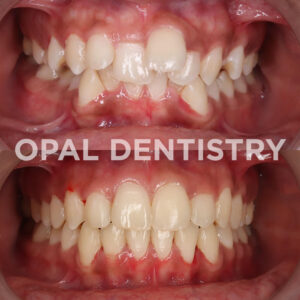Introduction
Invisalign braces have revolutionized orthodontic treatment, especially for kids. These transparent aligners offer a discreet and comfortable alternative to traditional metal braces. If you’re considering Invisalign braces for your child, this comprehensive guide will provide you with all the essential information you need. From understanding how Invisalign works at Opal Dentistry to the benefits and care instructions, we’ll cover it all. Let’s dive into the world of Invisalign braces for kids!

What is Invisalign?
Invisalign is an orthodontic treatment method that utilizes a series of transparent, custom-made aligners to straighten teeth gradually. These aligners are made from a patented thermoplastic material, ensuring a comfortable fit. Invisalign is designed to be virtually invisible, allowing kids to undergo orthodontic treatment without the self-consciousness often associated with traditional braces.
How Does Invisalign Work on Kids?
Invisalign treatment begins with a consultation with our orthodontist who specializes in Invisalign. Our orthodontist will assess your child’s teeth and create a customized treatment plan. Using advanced computer imaging technology, a series of aligners will be created to fit your child’s teeth precisely. Each set of aligners is worn for approximately two weeks before progressing to the next set. Over time, the aligners gently and gradually shift the teeth into their desired positions. Regular check-ups with our orthodontist will be scheduled to monitor progress and provide new aligners as needed.
Benefits of Invisalign for Kids
• Aesthetics: Invisalign aligners are virtually invisible, allowing kids to smile confidently throughout their treatment.
• Comfort: The smooth, thermoplastic material used in Invisalign aligners ensures a comfortable fit without the irritation that can be caused by metal brackets and wires.
• Removable: Invisalign aligners can be removed for eating, brushing, and flossing, making oral hygiene routines easier and more effective.
• Minimal Dietary Restrictions: Unlike traditional braces, Invisalign allows kids to enjoy their favourite foods without worrying about damaging brackets or wires.
• Fewer Orthodontic Appointments: Invisalign treatment in Opal Dentistry typically requires fewer orthodontic visits compared to traditional braces, saving time and minimizing disruptions to your child’s daily routine.
Candidacy for Invisalign Braces
While Invisalign is suitable for many orthodontic cases, it may not be suitable for all kids. Mild to moderate dental misalignments, such as overcrowding, gaps, and mild bite issues, are generally well-suited for Invisalign treatment. Complex orthodontic issues may still require traditional braces.
During the consultation, the orthodontist will evaluate your child’s specific needs and determine if they are a suitable candidate for Invisalign. In some cases, the orthodontist may recommend a combination of traditional braces and Invisalign treatment.
Caring for Invisalign Braces
• Proper care is essential to ensure the success of Invisalign treatment. Here are some key guidelines to follow:
• Remove the aligners when eating or drinking anything other than water to prevent staining and warping.
• Clean the aligners daily using a soft-bristled toothbrush and mild antibacterial soap or Invisalign cleaning crystals.
• Brush and floss your child’s teeth thoroughly before reinserting the aligners to maintain oral hygiene.
• Avoid exposing the aligners to hot temperatures, as they can deform the plastic material.
• Keep the aligners in their protective case when not in use to prevent loss or damage.
Comparing Traditional Braces and Invisalign for Kids
When considering orthodontic treatment for your child, it’s important to compare the differences between traditional braces and Invisalign. Here’s a brief comparison to help you make an informed decision:
a. Appearance: Traditional braces are easily noticeable, with metal brackets and wires on the teeth. Invisalign aligners, on the other hand, are virtually invisible, allowing kids to undergo treatment without feeling self-conscious.
b. Comfort: Metal braces may cause discomfort and irritation due to the brackets and wires. Invisalign aligners are made of smooth thermoplastic material, providing a more comfortable experience for your child.
c. Removability: Traditional braces are fixed appliances that cannot be removed by the wearer. Invisalign aligners, however, are removable, allowing kids to eat their favourite foods and maintain oral hygiene with ease.
d. Dietary Restrictions: With traditional braces, certain foods like sticky candies, popcorn, and hard fruits need to be avoided to prevent damage to the brackets and wires. Invisalign aligners eliminate these dietary restrictions since they can be removed during meals.
e. Oral Hygiene: Brushing and flossing can be more challenging with traditional braces, as they require special tools to clean around the brackets and wires. Invisalign aligners can be taken out, allowing for easy oral hygiene maintenance.
f. Treatment Duration: The treatment duration for both traditional braces and Invisalign may vary depending on the individual case. Invisalign treatment generally requires fewer orthodontic appointments and can be completed within a similar timeframe as traditional braces.
Invisalign braces offer a convenient and aesthetically pleasing alternative to traditional braces for kids. With their transparent aligners, comfort, and removability, Invisalign aligners provide numerous benefits for orthodontic treatment. However, it’s essential to consult with an orthodontist to determine if your child is a suitable candidate for Invisalign. By comparing the features and benefits of Invisalign with traditional braces, you can make an informed decision that best suits your child’s orthodontic needs. Invest in your child’s smile and provide them with a comfortable and discreet orthodontic treatment experience with Invisalign braces.

Invisalign Treament at Opal Dentistry
Remember, each child’s orthodontic needs are unique, so it’s crucial to consult with a qualified orthodontist from Opal Dentistry to determine the most appropriate treatment option for your child.